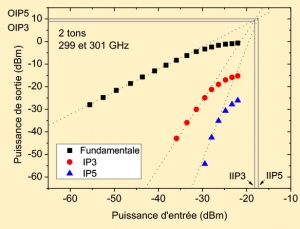Component measurement techniques for 6G
In the perspective of the 6th generation of mobile telephony, planned for 2030. The band around 300 GHz is already identified, and the first components and soon transmission systems will emerge, based on multiple technologies, which may be based on a combination of silicon and III-V technologies. One of the key points of these systems is the realization of power components in the 300 GHz range to increase the range of these systems. In order to evaluate the performance of active circuits, the measurement of intermodulation in bi-tone injection is essential. The principle of this type of measurement lies in the fact of injecting two frequencies into the component to be measured at the same time. However, achieving a bi-tone generation at 300 GHz is not easy. The technique developed here is to use an opto-electronic source capable of converting an optical signal at 1.55 µm (wavelengths of optical fibers) into a 300 GHz signal.
This type of component also allows to easily generate a series of frequencies at the same time when it is subjected to several wavelengths in input. With this dual-frequency (« dual-tone ») source in place, it has been shown for the first time [REF] that the characterization in IP3 and IP5 (3rd and 5th order non-linearities) of active components becomes possible in the 300 GHz band using this technique. Moreover, since the optoelectronic approach also allows the measurement of the noise figure of the circuit, the noise/power measurement is obtained on a given device, in one go. The tested component is an active circuit of HEMT technology at 300 GHz, performing the function of LNA (low-noise amplifier)
H. Ghanem, S. Lépilliet, F. Danneville and G. Ducournau, « 300-GHz Intermodulation/Noise Characterization Enabled by a Single THz Photonics Source, » in IEEE Microwave and Wireless Components Letters, vol. 30, no. 10, pp. 1013-1016, Oct. 2020,
https://dx.doi.org/10.1109/LMWC.2020.3020817














